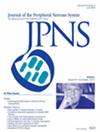New Approaches Based on Serial-Block Face Electron Microscopy to Investigate the Peripheral Nervous System
Abstract
Background and Aims
Serial block face scanning electron microscopy (SBF-SEM) enables automated 3D imaging of specimens with ultrastructural resolution. However, its application is often restricted due to the complex and labor-intensive nature of the processes involved. This study addresses the challenges associated with sample preparation and the final 3D reconstruction for ultrastructural analysis of peripheral nerves and dorsal root ganglia (DRG) specimens.
Methods
Specimens from the caudal nerve and DRG of mice were prepared for SBF-SEM using three different techniques: (1) manual high molecular weight staining, regarded as the gold standard, (2) automated standard transmission electron microscopy (TEM) preparation, and (3) automated uranyl-free en bloc preparation. The acquired data were processed by combining different software programs for image analysis and 3D rendering.
Results
Upon analyzing all samples, the high molecular weight method demonstrated its superiority. Nonetheless, the two alternative methods produced high-quality images of the caudal nerve. Consequently, 3D rendering was successfully achieved for all samples using an automated approach. The investigation of DRG specimens posed greater challenges with the standard TEM preparation due to the low contrast of smaller organelles compared to the cytosol, whereas the uranyl-free protocol provided significantly improved contrast.
Interpretation
Our findings indicate that automated uranyl-free staining can effectively compete with the traditional gold standard manual and uranyl-based staining methods, albeit with some limitations. Furthermore, high-quality SBF-SEM imaging is attainable, especially in peripheral nerves, using samples prepared via the standard TEM method, thereby facilitating the analysis of previously embedded samples even if they were not specifically prepared for 3D examination.


 求助内容:
求助内容: 应助结果提醒方式:
应助结果提醒方式:


